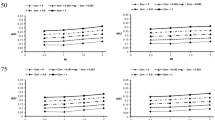Abstract
We examine methods for measuring performance in signal-detection-like tasks when each participant provides only a few observations. Monte Carlo simulations demonstrate that standard statistical techniques applied to ad’ analysis can lead to large numbers of Type I errors (incorrectly rejecting a hypothesis of no difference). Various statistical methods were compared in terms of their Type I and Type II error (incorrectly accepting a hypothesis of no difference) rates. Our conclusions are the same whether these two types of errors are weighted equally or Type I errors are weighted more heavily. The most promising method is to combine an aggregated’ measure with a percentile bootstrap confidence interval, a computerintensive nonparametric method of statistical inference. Researchers who prefer statistical techniques more commonly used in psychology, such as a repeated measurest test, should useγ (Goodman & Kruskal, 1954), since it performs slightly better than or nearly as well asd’. In general, when repeated measurest tests are used,γ is more conservative thand’: It makes more Type II errors, but its Type I error rate tends to be much closer to that of the traditional .05 α level. It is somewhat surprising thatγ performs as well as it does, given that the simulations that generated the hypothetical data conformed completely to thed’ model. Analyses in which H—FA was used had the highest Type I error rates. Detailed simulation results can be downloaded fromwww.psychonomic.org/archive/Schooler-BRM-2004.zip.
Similar content being viewed by others
References
Cohen, J. (1988).Statistical power analysis for the behavioral sciences (2nd ed.). Hillsdale, NJ: Erlbaum.
Deese, J. (1959). On the prediction of occurrence of particular verbal intrusions in immediate recall.Journal of Experimental Psychology,58, 17–22.
Di Stefano, J. (2003). How much power is enough? Against the development of an arbitrary convention for statistical power calculations.Functional Ecology,17, 707–709.
Efron, B., &Tibshirani, R. (1991). Bootstrap methods for standard errors, confidence intervals, and other measures of statistical accuracy.Statistical Science,1, 54–77.
Gallo, D. A., Roediger, H. L., III, &McDermott, K. B. (2001). Associative false recognition occurs without strategic criterion shifts.Psychonomic Bulletin & Review,8, 579–586.
Goodman, L. A., &Kruskal, W. H. (1954). Measures of association for cross classifications.Journal of the American Statistical Association,49, 732–764.
Green, D. M., &Swets, J. A. (1966).Signal detection theory and psychophysics. New York: Wiley.
Heit, E., Brockdorff, N., &Lamberts, K. (2003). Adaptive changes of response criterion in recognition memory.Psychonomic Bulletin & Review,10, 718–723.
Martinez W. L., &Martinez A. R. (2002).Computational statistics handbook with MATLAB. New York: Chapman & Hall/CRC.
Miller, M. B., &Wolford, G. L. (1999). Theoretical commentary: The role of criterion shift in false memory.Psychological Review,106, 398–405.
Mooney, C. Z., &Duval, R. D. (1993).Bootstrapping: A nonparametric approach to statistical inference. London: Sage.
Nelson, T. O. (1984). A comparison of current measures of the accuracy of feeling-of-knowing predictions.Psychological Bulletin,95, 109–133.
Read, J. D. (1996). From a passing thought to a false memory in 2 minutes: Confusing real and illusory events.Psychonomic Bulletin & Review,3, 105–111.
Roediger, H. L., III, &McDermott, K. B. (1995). Creating false memories: Remembering words that were not presented in lists.Journal of Experimental Psychology: Learning, Memory, & Cognition,21, 803–814.
Snodgrass, J. G., &Corwin, J. (1988). Pragmatics of measuring recognition memory: Applications to dementia and amnesia.Journal of Experimental Psychology: General,117, 34–50.
Stretch, V., &Wixted, J. T. (1998). On the difference between strengthbased and frequency-based mirror effects in recognition memory.Journal of Experimental Psychology: Learning, Memory, & Cognition,24, 1379–1396.
Wixted, J. T., &Stretch, V. (2000). The case against a criterion-shift account of false memory.Psychological Review,107, 368–376.
Zoubir, A. M., &Boashash, B. (1998). The bootstrap and its application in signal processing.IEEE Signal Processing Magazine,15, 56–76.
Author information
Authors and Affiliations
Corresponding author
Additional information
This work was begun while L.S. was supported by NSRA Fellowship 1F32HD/MHC7787-01A1 at Indiana University.
Note—This article was accepted by the previous editor, Jonathan Vaughan.
Electronic supplementary material
Rights and permissions
About this article
Cite this article
Schooler, L.J., Shiffrin, R.M. Efficiently measuring recognition performance with sparse data. Behavior Research Methods 37, 3–10 (2005). https://doi.org/10.3758/BF03206393
Received:
Accepted:
Published:
Issue Date:
DOI: https://doi.org/10.3758/BF03206393




